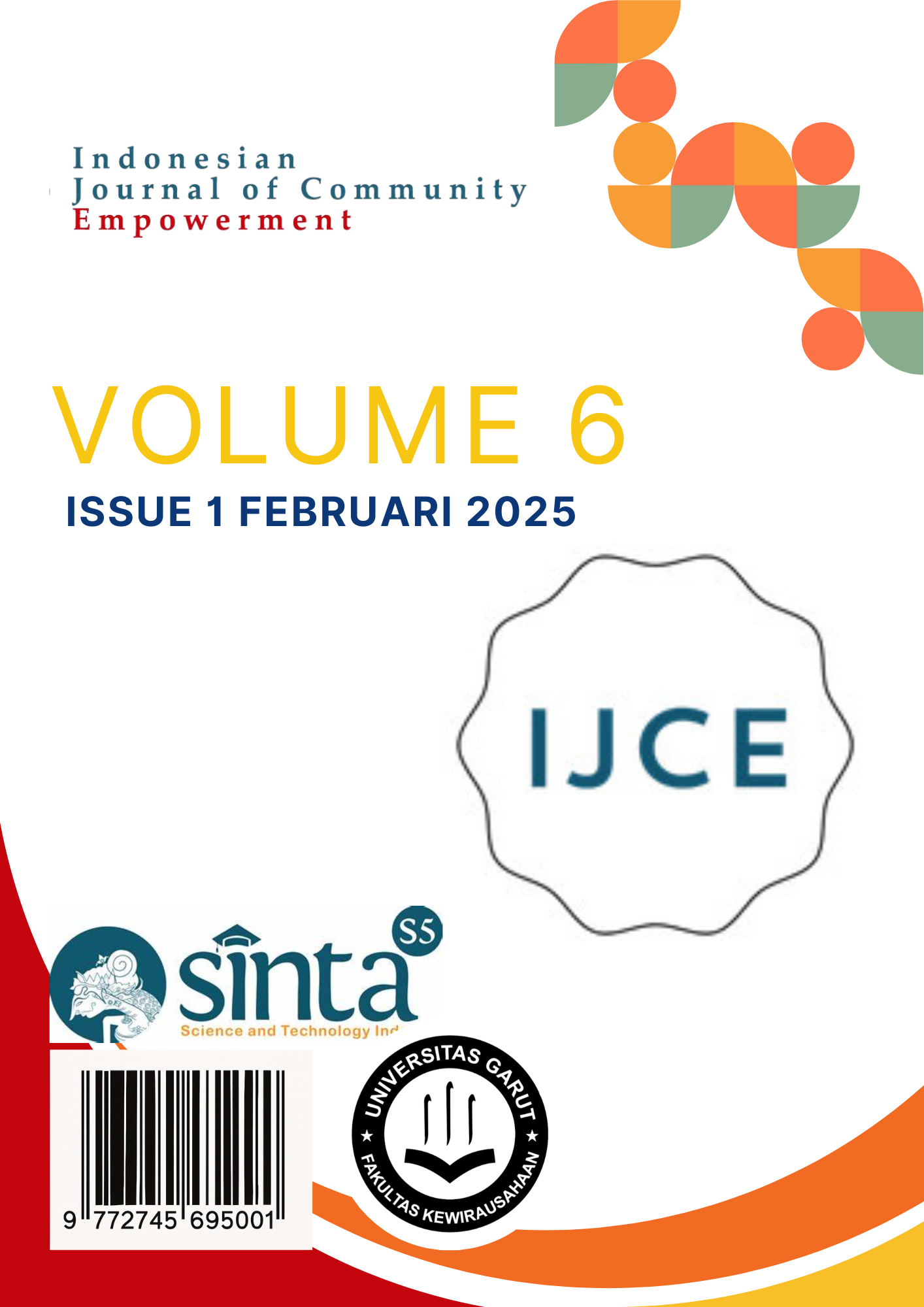AI-Based Training: ‘Speaking with Stimuler’ Program at SMAN 11 Garut
Abstract
This community service program was carried out at SMAN 11 Garut with the aim of enhancing students’ speaking skills through the application of Artificial Intelligence (AI) using the “Speaking with Stimuler” approach. The activity was conducted in two stages, namely the delivery of materials by the service team and a hands-on practice session facilitated by the students. The results show that the integration of AI in speaking practice contributes to improving students’ language abilities, fostering more interactive learning experiences, and reducing repetitive burdens in the teaching process. Despite several challenges such as the need for continuous training and readiness of supporting infrastructure, the program proved effective in increasing students’ enthusiasm and competence. This activity highlights the potential of AI-based learning models as an innovative method to strengthen speaking skills in the context of secondary education.
Keywords: Artificial Intelligence1; Speaking with Stimuler2; language learning3; community service4
References
Y. Supriady, “Pelatihan Pemanfaatan Artificial Intelligence (Ai) Untuk Guru Di SMK Widya Dirgantara,” Merpati Media Publ. Pengabdi. Kpd. Masy. Politek. Pos Indones., vol. 6, no. 2, pp. 96–102, 2025, doi: 10.36618/merpati.v6i2.4156.
T. W. P. Mukti, M. Wulandari, R. A. Purnamaningwulan, and F. X. R. Baskara, “Pelatihan Penggunaan AI Dalam Pengajaran Bahasa Inggris Bagi Guru MGMP Bahasa Inggris Kabupaten Bantul,” Madaniya, vol. 5, no. 3, pp. 859–869, 2024, doi: 10.53696/27214834.855.
P. I. Talenta et al., “Pelatihan Optimalisasi AI Dalam Pembelajaran Bahasa Inggris Bagi Guru-Guru MGMP Bahasa Inggris SMA/MA Kota Semarang,” Bima Abdi J. Pengabdi. Masy., vol. 4, no. 4, pp. 259–269, 2024, doi: 10.53299/bajpm.v4i4.1036.
L. Ahluwalia, S. Angelica, B. Permatasari, and A. D. Putri, “Implementasi Artificial Intellegence Dan Aplikasi Digital Marketing Dalam Optimalisasi Potensi Umkm Desa Hanura, Pesawaran,” Comment, vol. 3, no. 1, pp. 32–40, 2023, doi: 10.33365/comment.v3i1.292.
R. Ruwaidah, B. Megawati, M. Ritonga, R. Aditiya, A. H. Sagala, and W. A. Ritonga, “Pelatihan Pembuatan Media Pembelajaran Menggunakan Artificial Intelligence /Ai Untuk Meningkatkan Keterampilan Pembelajaran,” J-Coscis J. Comput. Sci. Community Serv., vol. 4, no. 2, pp. 205–214, 2024, doi: 10.31849/jcoscis.v4i2.19810.
D. Maharani, D. Anggraeni, and R. Nofitri, “Pemanfaatan Artificial Intelligence Dalam Pembuatan Presentasi Bagi Guru-Guru Brainfor Islamic School Kisaran,” J. Indones. Soc. Soc., vol. 2, no. 1, pp. 45–51, 2024, doi: 10.59435/jiss.v2i1.219.
A. Muhardono, W. A. Sunarjo, D. A. Murty, S. B. Aji, and T. L. Sari, “Pelatihan Optimalisasi Konten Marketing Menggunakan Aplikasi Artificial Intellegence (AI) Bagi UMKM Kampoeng Batik Kauman Pekalongan,” I-Com Indones. Community J., vol. 4, no. 3, pp. 1959–1968, 2024, doi: 10.33379/icom.v4i3.5108.
H. Thamrin, Z. Fatkhurrahman, and M. L. Arsyad, “Pelatihan Aplikasi Kecerdasan Buatan Dalam Pendidikan Bagi Dosen UMMAD,” Abdi Teknoyasa, pp. 291–295, 2024, doi: 10.23917/abditeknoyasa.v5i1.5656.
D. Firmansyah et al., “Seminar Introduction AI: Membangun Kesiapan Guru Menghadapi Pembaharuan Teknologi Pendidikan Di SDN 15 Cakranegara,” Rengganis J. Pengabdi. Masy., vol. 4, no. 2, pp. 266–274, 2024, doi: 10.29303/rengganis.v4i2.446.
T. X. Nguyen, “English Majors’ Perceptions of AI Tool Application in English Language Learning at Tertiary Level in Vietnam,” J. Knowl. Learn. Sci. Technol. Issn 2959-6386, vol. 3, no. 1, pp. 179–193, 2024, doi: 10.60087/jklst.vol3.n1.p193.
M. Leddy and N. M. Creanor, “Exploring How Education Can Leverage Artificial Intelligence for Social Good,” Eur. Conf. Innov. Entrep., vol. 19, no. 1, pp. 1041–1048, 2024, doi: 10.34190/ecie.19.1.2906.
W. Alharbi, “AI in the Foreign Language Classroom: A Pedagogical Overview of Automated Writing Assistance Tools,” Educ. Res. Int., vol. 2023, pp. 1–15, 2023, doi: 10.1155/2023/4253331.
M. Rožman, D. Oreški, and P. Tominc, “Artificial-Intelligence-Supported Reduction of Employees’ Workload to Increase the Company’s Performance in Today’s VUCA Environment,” Sustainability, vol. 15, no. 6, p. 5019, 2023, doi: 10.3390/su15065019.
V. K. V -, “AI-Driven Compliance Training in Finance and Healthcare: A Paradigm Shift in Regulatory Adherence,” Int. J. Multidiscip. Res., vol. 6, no. 6, 2024, doi: 10.36948/ijfmr.2024.v06i06.30180.
Z. Chen, “Responsible AI in Organizational Training: Applications, Implications, and Recommendations for Future Development,” Hum. Resour. Dev. Rev., vol. 23, no. 4, pp. 498–521, 2024, doi: 10.1177/15344843241273316.
S. Zilcha‐Mano, “A Glance Into the Future of Artificial Intelligence-Enhanced Scalable Personalized Training: A Response to Kopelovich, Brian, Et Al. (2025) and Kopelovich, Slevin, Et Al. (2025).,” Psychotherapy, vol. 62, no. 1, pp. 22–27, 2025, doi: 10.1037/pst0000547.
S. E. Mwakalinga, “The Use of Artificial Intelligence in Teaching and Learning: Opportunities and Challenges. Students vs Lecturers Perception,” Int. J. Multidiscip. Res., vol. 6, no. 5, 2024, doi: 10.36948/ijfmr.2024.v06i05.28339.













